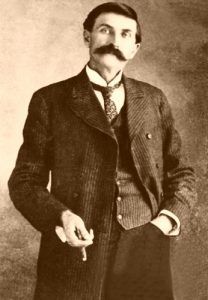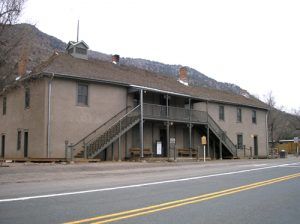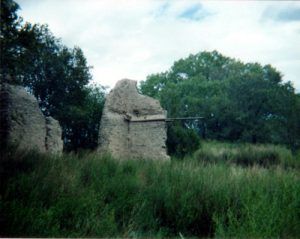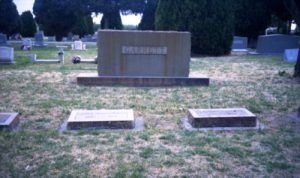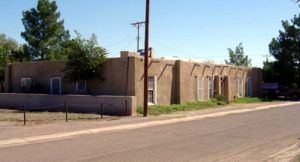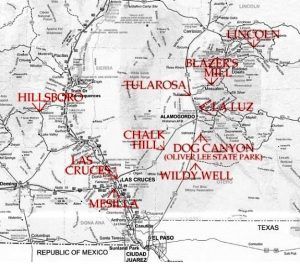by Corey Recko
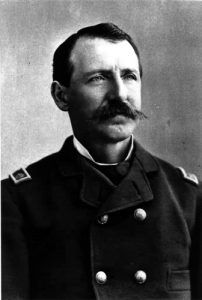
Colonel Albert Jennings Fountain
At the end of January 1896, Colonel Albert Jennings Fountain assisted in bringing indictments against several men, including Oliver Lee and William McNew, to combat the cattle rustling that raged in New Mexico territory. His work done, Fountain left Lincoln, New Mexico, with his eight-year-old son Henry and headed southwest toward their home in Mesilla. It was a home they would never see again, for they disappeared near White Sands on the third day of their journey. What became of them remains one of New Mexico’s greatest mysteries.
The Fountains’ murder caused outrage in New Mexico. The sheriff, whose deputies were the prime suspects, was useless. To top it off, his right to the office was being challenged in the courts due to charges of election fraud. Governor William T. Thornton took quick action. He worked to resolve the sheriff’s contest and then appointed Pat Garrett Sheriff. Garrett had gained fame 15 years earlier as the man who killed Billy the Kid. He had cleaned up a bad situation before and hoped he could do it again.
Thornton then called on the Pinkerton National Detective Agency to assign a professional investigator to assist Garrett. The Pinkertons put top operative John Fraser, on the case. Fraser began undercover but eventually brought his investigation out in the open and interviewed anyone with knowledge of the case. Fraser and Garrett did not always get along but managed to work together for the common goal.
The evidence pointed at three men: former deputy William McNew, James Gililland, and Oliver Lee. The problem was that these three men were very close with powerful ex-judge, lawyer, and politician Albert B. Fall. Some even said that Fall was the mastermind behind the plot to kill Fountain.
Garrett believed that he would never get a fair showing with Fall in control of the courts. As a result, Garrett waited two full years for a change in the political landscape before presenting his evidence to the court and securing indictments against the suspects.
McNew was quickly arrested after indictments were secured. Lee and Gililland, however, were a different story. Lee claimed that Garrett only wanted a chance to kill him, with a warrant for the murder of Fountain as an excuse. He and Gililland remained on the lam. Garrett finally tracked down the fugitives at one of Lee’s ranches. Lee and Gililland got the best of the Sheriff’s posse in the ensuing gun battle. One of Garrett’s deputies was killed, and Garrett and his two remaining deputies were forced to retreat.
Lincoln:
Fountain began his trip in the town of Lincoln. Located high in the Capitan Mountains, historic Lincoln has remained much unchanged in the last 100-plus years. The town gained fame as the center of the Lincoln County War. The courthouse still stands where Billy the Kid made his daring last escape. In fact, it was this courthouse where, 15 years after Billy’s escape, Colonel Fountain worked as a special assistant to the prosecutor to bring charges against some of the same cattle rustlers who would later be accused of taking his life.
Lee and Gililland would finally surrender months later, under the condition that they would never be in the custody of Sheriff Garrett.
The trial took place in the secluded town of Hillsboro. The murders of the Fountains were all but forgotten as the defendants, along with their attorney Fall, became media darlings.
Some witnesses went missing, and the defendants’ armed supporters, who packed the courtroom, intimidated others. A verdict of “not guilty” was found. Lee, Gililland, McNew, their attorneys, and many supporters celebrated into the night.
The bodies of Albert Fountain and his young son Henry still lay in an unmarked grave, the location of which remains a mystery.
Over one hundred years have passed since this saga unfolded. The participants are gone, but the story and many places where it happened live on.
Blazer’s Mill:
Albert Fountain and his son Henry spent the first night of their trip home as a guest of Joseph Blazer. Blazer purchased a sawmill in 1868. It burned down in 1870 and was rebuilt, after which it became known as Blazer’s Mill. In addition to the production of lumber, Blazer’s Mill, which was located on, but was not part of, the Mescalero Apache reservation, served as a licensed trader on the reservation. This is another site with Lincoln County War connections, as the location of the classic gun battle that took the lives of Richard Brewer and Andrew “Buckshot” Roberts. Not much is left of Blazer’s Mill today. The big house where Joseph Blazer lived is gone. But the remains of the mill and the only building that still stands offer a glimpse of the past.
Tularosa:
After leaving Blazer’s Mill, Fountain became aware of two horsemen following him in the distance. The men were never near enough to recognize. They passed through Tularosa. While in Tularosa, one can see the grave of one of the men tried for the Fountains’ murder. James Gililland, alongside his wife, is buried at Fairview Cemetery.
La Luz:
Albert and Henry spent their last night on Earth in La Luz, at the home of David Sutherland. The next day they’d start the long stretch to Las Cruces, now with three horsemen following them.
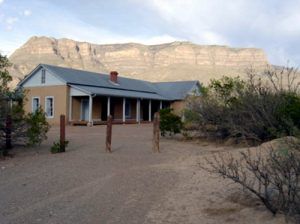
Oliver Lee’s Dog Canyon Ranch House is now part of a New Mexico State Park, 2004, photo by Corey Recko.
Oliver Lee State Park:
When the search parties found Fountain’s plundered buckboard and signs of foul play, they followed the tracks of three horsemen that led away from the buckboard. Though a herd of cattle had trampled two sets of tracks, they appeared to lead towards two ranches owned by Oliver Lee, according to some in the searching party. These were Dog Canyon and Wildy Well. The Dog Canyon Ranch, with a restored ranch house, is now Oliver Lee Memorial State Park.
Wildy Well:
Besides being the alleged destination of one of the horsemen involved in the Fountain murder, Oliver Lee’s Wildy Well ranch also served as the site of a gun battle between suspects Oliver Lee and James Gililland and Sheriff Pat Garrett and his posse. The Sheriff and his men were forced to retreat and lost one man in the fight.
Fountain Historical Marker/Chalk Hill:
Fountain’s buckboard left the road just past Chalk Hill, where the road cuts through, and the banks are high. A pool of blood was found where the buckboard carrying the father and son left the road. Today a historical marker stands just west of Chalk Hill. The old wagon road is inaccessible as it is part of the White Sands Missile Range, but it can be seen south of the road. It was there that the Fountains’ homeward journey came to an abrupt end.
Masonic Cemetery, Las Cruces:
If the dead could speak, a lot could be learned from a visit to the Masonic Cemetery in Las Cruces. Thomas Branigan and his wife rest here. Branigan, a member of the initial search party for the Fountains, was a community leader in Las Cruces for years. William Llewellyn, leader of the search party, is buried near Branigan. Llewellyn, one of Roosevelt’s “Rough Riders” in the Spanish-American War, was actively involved in investigating Fountain’s murderers. Llewellyn’s son Morgan, a guide and interpreter for the Pinkerton detective on a trip to various sites important to the case, also rests here.
Pat Garrett, the famous Sheriff, is here along with his wife and children. Markers also sit over plots reserved for Colonel Fountain and Henry Fountain in the hope that their bodies will one day be found.
Mesilla:
Fountain’s home from 1873 until his death, Mesilla still retains much of the charm that it had in the 1890s. Be sure to walk the plaza while there. The house Albert Fountain owned when he disappeared is located south of the plaza.
Gadsden Museum:
While in Mesilla, no journey into the past would be complete without a stop at the Gadsden Museum. Run by direct descendants of Colonel Fountain, the museum is dedicated to local history and the Fountain’s history. The museum is located on the corner of Barker Road and Highway 28.
Mesilla Cemetery:
Many members of the Fountain family are in this little cemetery south of Mesilla, including the Colonel’s wife, Mariana, and their son Albert (who was involved in the initial search party.)
Hillsboro:
The Fountain story ended in the small mining town of Hillsboro in 1899. The trial of suspects Oliver Lee and James Gililland took place there thanks to a change of venue. The courthouse has been partially knocked down, but the remains of the brick walls still stand. One can still get a sense of the courthouse that once stood here. The fallen bricks and the dirt and weeds inside add character to this relic of the past. The jail behind the courthouse is much more intact.
It’s been over a hundred years since Albert and Henry disappeared, and the trial and acquittal of their accused killers took place. The trial coincided with the end of a century and a way of life. The lawlessness that defined territorial New Mexico soon ended, and the territory became a state.
Since then, the automobile has replaced the horse. Cities have been built up, and pavement put down. The old west may be gone, but the stories from the past are still visible: you just have to know where to look.
© Corey Recko, 2007, edited by Kathy Alexander/Legends of America, updated November 2023.
About the Author: Corey Recko is the author of Murder on the White Sands: The Disappearance of Albert and Henry Fountain (University of North Texas Press, 2007). He is an avid reader of history with extensive knowledge of late nineteenth-century New Mexico. His interest in the Fountain case led to six years of research and writing. He is a member of several historical societies. Born and raised in Cleveland, Ohio, Recko now makes his home in Los Angeles, California. For more information, go to www.coreyrecko.com.
Also See:
Albert Jennings Fountain – Missing in the Desert
Pat Garrett – An Unlucky Lawman

